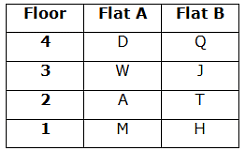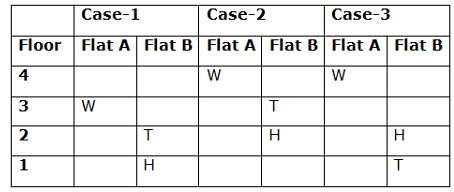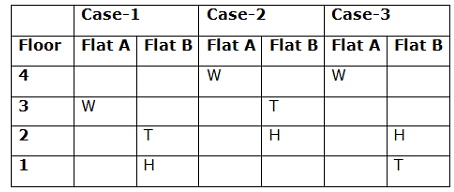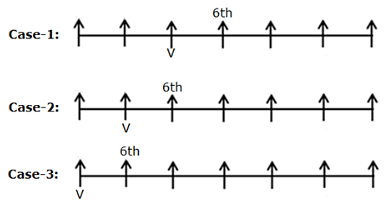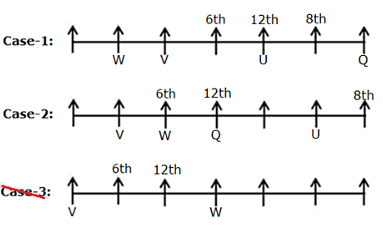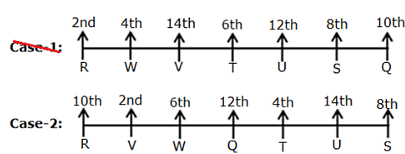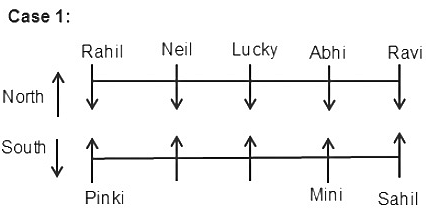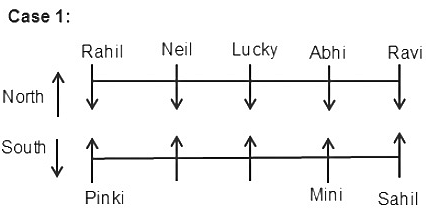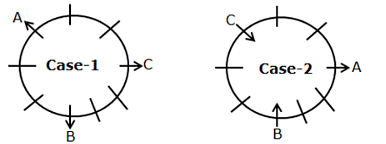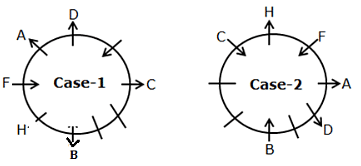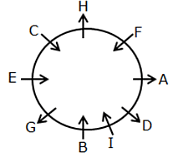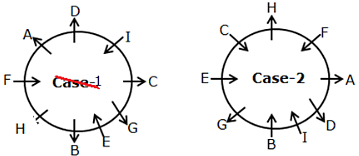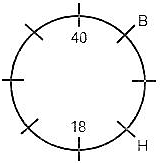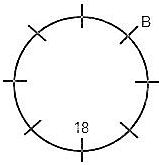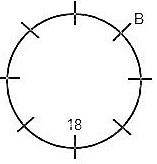IBPS RRB PO (Scale 1) Prelims Mock Test - 8 - Banking Exams MCQ
30 Questions MCQ Test - IBPS RRB PO (Scale 1) Prelims Mock Test - 8
Direction: The following questions are based on the three-digit numbers given below. Study the information carefully and answer the questions.
245 854 457 652 129
If we interchange the first and second digits of each number then which number will be the lowest among them?
Direction: The following questions are based on the three-digit numbers given below. Study the information carefully and answer the questions.
245 854 457 652 129
If all the three digits of each of the numbers are added the resulting sum of which of the following numbers will be a perfect square?
Direction: The following questions are based on the three-digit numbers given below. Study the information carefully and answer the questions.
245 854 457 652 129
If all the three digits of each number are arranged in ascending order and then all the numbers are arranged in decreasing order then find which element will be third from left end?
Direction: The following questions are based on the three-digit numbers given below. Study the information carefully and answer the questions.
245 854 457 652 129
If in each number second and third digits are interchanged, then how many even numbers are there?
Study the following information carefully and answer the questions given below.
Eight persons - A, D, H, J, M, Q, T and W are living in two different flats viz. Flat A and Flat B of a four-storey building, but not necessarily in the same order. Flat A is exactly to the west of Flat B. The bottommost floor is numbered as 1 and the floor immediately above is numbered as 2 and so on.
W lives two floors above H, where both of them live in different flats. T lives southeast of W. The number of floors above T is one less than the number of floors below D, who doesn’t live in the same flat as H. J lives immediately below D. Q lives northeast of A, who doesn’t live southwest of H. Both M and T doesn’t live on the same floor.
Who among the following person lives in flat A of floor 1?
Study the following information carefully and answer the questions given below.
Eight persons - A, D, H, J, M, Q, T and W are living in two different flats viz. Flat A and Flat B of a four-storey building, but not necessarily in the same order. Flat A is exactly to the west of Flat B. The bottommost floor is numbered as 1 and the floor immediately above is numbered as 2 and so on.
W lives two floors above H, where both of them live in different flats. T lives southeast of W. The number of floors above T is one less than the number of floors below D, who doesn’t live in the same flat as H. J lives immediately below D. Q lives northeast of A, who doesn’t live southwest of H. Both M and T doesn’t live on the same floor.
Who among the following person lives immediately below W?
Study the following information carefully and answer the questions given below.
Eight persons - A, D, H, J, M, Q, T and W are living in two different flats viz. Flat A and Flat B of a four-storey building, but not necessarily in the same order. Flat A is exactly to the west of Flat B. The bottommost floor is numbered as 1 and the floor immediately above is numbered as 2 and so on.
W lives two floors above H, where both of them live in different flats. T lives southeast of W. The number of floors above T is one less than the number of floors below D, who doesn’t live in the same flat as H. J lives immediately below D. Q lives northeast of A, who doesn’t live southwest of H. Both M and T doesn’t live on the same floor.
Four of the following five are alike in a certain way as per the given arrangement and hence form a group. Find the one who doesn’t belong to that group.
Study the following information carefully and answer the questions given below.
Eight persons - A, D, H, J, M, Q, T and W are living in two different flats viz. Flat A and Flat B of a four-storey building, but not necessarily in the same order. Flat A is exactly to the west of Flat B. The bottommost floor is numbered as 1 and the floor immediately above is numbered as 2 and so on.
W lives two floors above H, where both of them live in different flats. T lives southeast of W. The number of floors above T is one less than the number of floors below D, who doesn’t live in the same flat as H. J lives immediately below D. Q lives northeast of A, who doesn’t live southwest of H. Both M and T doesn’t live on the same floor.
The number of floors above J is same as the floors below ___.
Study the following information carefully and answer the questions given below.
Eight persons - A, D, H, J, M, Q, T and W are living in two different flats viz. Flat A and Flat B of a four-storey building, but not necessarily in the same order. Flat A is exactly to the west of Flat B. The bottommost floor is numbered as 1 and the floor immediately above is numbered as 2 and so on.
W lives two floors above H, where both of them live in different flats. T lives southeast of W. The number of floors above T is one less than the number of floors below D, who doesn’t live in the same flat as H. J lives immediately below D. Q lives northeast of A, who doesn’t live southwest of H. Both M and T doesn’t live on the same floor.
H lives on which of the following floor and flat?
Direction: Study the following information carefully and answer the given questions.
In a certain code language,
‘di ma ti bi’ means ‘sky is blue colour’,
‘ti ja ma pa’ means ‘moon colour is white’,
‘ma ca fo ti’ means ‘sun is red colour’,
’ma di ko’ means ‘ocean is blue’.
Which of the following means ‘red’ in that code language?
Direction: Study the following information carefully and answer the given questions.
In a certain code language,
‘di ma ti bi’ means ‘sky is blue colour’,
‘ti ja ma pa’ means ‘moon colour is white’,
‘ma ca fo ti’ means ‘sun is red colour’,
’ma di ko’ means ‘ocean is blue’.
Which of the following means ‘moon’ in that code language?
Direction: Study the following information carefully and answer the given questions.
In a certain code language,
‘di ma ti bi’ means ‘sky is blue colour’,
‘ti ja ma pa’ means ‘moon colour is white’,
‘ma ca fo ti’ means ‘sun is red colour’,
’ma di ko’ means ‘ocean is blue’.
Code ‘ti’ is for which word in the given language?
Study the following information carefully and answer the questions given below.
Seven persons - Q, R, S, T, U, V and W are sitting in a linear row facing towards north, but not necessarily in the same order. Each person reads different pages in a book viz. 2nd, 4th, 6th, 8th, 10th, 12th and 14th.
Atleast three persons sit to the right of the one who reads 6th page. V sits immediate left of the one who reads 6th page. The one who reads 12th page sits two places away from V but doesn’t sit at any of the ends of the row. The number of persons sitting to the right of the one who reads 12th page is one more than the number of persons sits to the left of W. Only three persons sit between W and the one who reads 8th page. U sits immediate left of the one who reads 8th page. Q sits two places away from U. Neither R nor T reads 8th page. The one who reads 2nd page sits third to the left of T. The one who reads 14th page sits immediate right of the one who reads 4th page. Q doesn’t read 10th page.
R reads which of the following page?
Study the following information carefully and answer the questions given below.
Seven persons - Q, R, S, T, U, V and W are sitting in a linear row facing towards north, but not necessarily in the same order. Each person reads different pages in a book viz. 2nd, 4th, 6th, 8th, 10th, 12th and 14th.
Atleast three persons sit to the right of the one who reads 6th page. V sits immediate left of the one who reads 6th page. The one who reads 12th page sits two places away from V but doesn’t sit at any of the ends of the row. The number of persons sitting to the right of the one who reads 12th page is one more than the number of persons sits to the left of W. Only three persons sit between W and the one who reads 8th page. U sits immediate left of the one who reads 8th page. Q sits two places away from U. Neither R nor T reads 8th page. The one who reads 2nd page sits third to the left of T. The one who reads 14th page sits immediate right of the one who reads 4th page. Q doesn’t read 10th page.
The number of persons sitting to the right of the one who reads 10th page is the same as the number of persons sitting to the left of ___ .
Study the following information carefully and answer the questions given below.
Seven persons - Q, R, S, T, U, V and W are sitting in a linear row facing towards north, but not necessarily in the same order. Each person reads different pages in a book viz. 2nd, 4th, 6th, 8th, 10th, 12th and 14th.
Atleast three persons sit to the right of the one who reads 6th page. V sits immediate left of the one who reads 6th page. The one who reads 12th page sits two places away from V but doesn’t sit at any of the ends of the row. The number of persons sitting to the right of the one who reads 12th page is one more than the number of persons sits to the left of W. Only three persons sit between W and the one who reads 8th page. U sits immediate left of the one who reads 8th page. Q sits two places away from U. Neither R nor T reads 8th page. The one who reads 2nd page sits third to the left of T. The one who reads 14th page sits immediate right of the one who reads 4th page. Q doesn’t read 10th page.
Four of the following five are alike in a certain way as per the given arrangement and hence form a group. Find the one who doesn’t belong to that group.
Study the following information carefully and answer the questions given below.
Seven persons - Q, R, S, T, U, V and W are sitting in a linear row facing towards north, but not necessarily in the same order. Each person reads different pages in a book viz. 2nd, 4th, 6th, 8th, 10th, 12th and 14th.
Atleast three persons sit to the right of the one who reads 6th page. V sits immediate left of the one who reads 6th page. The one who reads 12th page sits two places away from V but doesn’t sit at any of the ends of the row. The number of persons sitting to the right of the one who reads 12th page is one more than the number of persons sits to the left of W. Only three persons sit between W and the one who reads 8th page. U sits immediate left of the one who reads 8th page. Q sits two places away from U. Neither R nor T reads 8th page. The one who reads 2nd page sits third to the left of T. The one who reads 14th page sits immediate right of the one who reads 4th page. Q doesn’t read 10th page.
What is the sum of the page numbers read by U and Q?
Study the following information carefully and answer the questions given below.
Seven persons - Q, R, S, T, U, V and W are sitting in a linear row facing towards north, but not necessarily in the same order. Each person reads different pages in a book viz. 2nd, 4th, 6th, 8th, 10th, 12th and 14th.
Atleast three persons sit to the right of the one who reads 6th page. V sits immediate left of the one who reads 6th page. The one who reads 12th page sits two places away from V but doesn’t sit at any of the ends of the row. The number of persons sitting to the right of the one who reads 12th page is one more than the number of persons sits to the left of W. Only three persons sit between W and the one who reads 8th page. U sits immediate left of the one who reads 8th page. Q sits two places away from U. Neither R nor T reads 8th page. The one who reads 2nd page sits third to the left of T. The one who reads 14th page sits immediate right of the one who reads 4th page. Q doesn’t read 10th page.
What is the position of T with respect to the one who reads 6th page?
Direction: Read the following information and answer the question given below
There are ten persons sitting in two parallel rows. Five persons Mini, Chetan, Sahil, Dolly and Pinki are facing north and the other five Abhi, Neil, Rahil, Ravi and Lucky are facing south. Each person from one row faces exactly one person from the other row but not necessarily in the same order.
Two people sit between Mini and Pinki who sit one of the extreme ends. Neil faces the immediate neighbor of Pinki. Ravi faces Sahil. Rahil sits second to the right of Lucky. Neither Rahil nor Neil faces Dolly.
Four are alike in some way. Find which of the following is different?
Direction: Read the following information and answer the question given below
There are ten persons sitting in two parallel rows. Five persons Mini, Chetan, Sahil, Dolly and Pinki are facing north and the other five Abhi, Neil, Rahil, Ravi and Lucky are facing south. Each person from one row faces exactly one person from the other row but not necessarily in the same order.
Two people sit between Mini and Pinki who sit one of the extreme ends. Neil faces the immediate neighbor of Pinki. Ravi faces Sahil. Rahil sits second to the right of Lucky. Neither Rahil nor Neil faces Dolly.
Who among the following sits opposite to Rahil?
Direction: Read the following information and answer the question given below
There are ten persons sitting in two parallel rows. Five persons Mini, Chetan, Sahil, Dolly and Pinki are facing north and the other five Abhi, Neil, Rahil, Ravi and Lucky are facing south. Each person from one row faces exactly one person from the other row but not necessarily in the same order.
Two people sit between Mini and Pinki who sit one of the extreme ends. Neil faces the immediate neighbor of Pinki. Ravi faces Sahil. Rahil sits second to the right of Lucky. Neither Rahil nor Neil faces Dolly.
Which of the following is true regarding Lucky?
Direction: Read the following information and answer the question given below
There are ten persons sitting in two parallel rows. Five persons Mini, Chetan, Sahil, Dolly and Pinki are facing north and the other five Abhi, Neil, Rahil, Ravi and Lucky are facing south. Each person from one row faces exactly one person from the other row but not necessarily in the same order.
Two people sit between Mini and Pinki who sit one of the extreme ends. Neil faces the immediate neighbor of Pinki. Ravi faces Sahil. Rahil sits second to the right of Lucky. Neither Rahil nor Neil faces Dolly.
Who is second to the left of Dolly?
Direction: Read the following information and answer the question given below
There are ten persons sitting in two parallel rows. Five persons Mini, Chetan, Sahil, Dolly and Pinki are facing north and the other five Abhi, Neil, Rahil, Ravi and Lucky are facing south. Each person from one row faces exactly one person from the other row but not necessarily in the same order.
Two people sit between Mini and Pinki who sit one of the extreme ends. Neil faces the immediate neighbor of Pinki. Ravi faces Sahil. Rahil sits second to the right of Lucky. Neither Rahil nor Neil faces Dolly.
How many persons sit between Rahil and Ravi?
Study the following information carefully and answer the questions given below.
Nine persons - A, B, C, D, E, F, G, H and I are sitting around a circular table in such a way that some of them are facing towards the center while some are facing away from the center, but not necessarily in the same order. Not more than two adjacent persons face the same direction.
A sits third to the right of B and faces away from the center. Two persons sit between A and C, who faces the same direction as B. Neither B nor C is an immediate neighbour of D. F sits second to the left of D, who faces away from the center. H sits immediate right of F. I sit third to the right of E, who sits immediate right of G. Both C and I are not immediate neighbours.
How many persons sit between D and E, when counted from the left of E?
Study the following information carefully and answer the questions given below.
Nine persons - A, B, C, D, E, F, G, H and I are sitting around a circular table in such a way that some of them are facing towards the center while some are facing away from the center, but not necessarily in the same order. Not more than two adjacent persons face the same direction.
A sits third to the right of B and faces away from the center. Two persons sit between A and C, who faces the same direction as B. Neither B nor C is an immediate neighbour of D. F sits second to the left of D, who faces away from the center. H sits immediate right of F. I sit third to the right of E, who sits immediate right of G. Both C and I are not immediate neighbours.
Who among the following person sits adjacent to I?
Study the following information carefully and answer the questions given below.
Nine persons - A, B, C, D, E, F, G, H and I are sitting around a circular table in such a way that some of them are facing towards the center while some are facing away from the center, but not necessarily in the same order. Not more than two adjacent persons face the same direction.
A sits third to the right of B and faces away from the center. Two persons sit between A and C, who faces the same direction as B. Neither B nor C is an immediate neighbour of D. F sits second to the left of D, who faces away from the center. H sits immediate right of F. I sit third to the right of E, who sits immediate right of G. Both C and I are not immediate neighbours.
If all the persons are made to sit in the alphabetical order in a clockwise direction with respect to A, then how many persons remain unchanged in their position, excluding A?
Study the following information carefully and answer the questions given below.
Nine persons - A, B, C, D, E, F, G, H and I are sitting around a circular table in such a way that some of them are facing towards the center while some are facing away from the center, but not necessarily in the same order. Not more than two adjacent persons face the same direction.
A sits third to the right of B and faces away from the center. Two persons sit between A and C, who faces the same direction as B. Neither B nor C is an immediate neighbour of D. F sits second to the left of D, who faces away from the center. H sits immediate right of F. I sit third to the right of E, who sits immediate right of G. Both C and I are not immediate neighbours.
Who among the following person sits immediate left of G?
Study the following information carefully and answer the questions given below.
Nine persons - A, B, C, D, E, F, G, H and I are sitting around a circular table in such a way that some of them are facing towards the center while some are facing away from the center, but not necessarily in the same order. Not more than two adjacent persons face the same direction.
A sits third to the right of B and faces away from the center. Two persons sit between A and C, who faces the same direction as B. Neither B nor C is an immediate neighbour of D. F sits second to the left of D, who faces away from the center. H sits immediate right of F. I sit third to the right of E, who sits immediate right of G. Both C and I are not immediate neighbours.
Four of the following five are alike in a certain way as per the given arrangement and hence form a group. Find the one who doesn’t belong to that group.
Direction: Study the information given below carefully and answer the question that follows.
Eight persons A, B, C, D, E, F, G, and H are sitting around a circular table facing the center but not necessarily in the same order. The age of these people is different from each other.
Following are the conditions used to determine the age of the persons.
Arrangement 1: M@ means that the age of the person sitting to the immediate left of M is twice as that of M.
Arrangement 2: M% means that the age of M is one-fourth the age of the person who is sitting second to her left.
Arrangement 3: M# means that the age of the person sitting third to the right of M is twice as that of M.
Only one person is sitting between B and H. A is sitting to the immediate right of D who is 20 years older than E. F is 25 years older than the person who is sitting immediate right of his. B is sitting third to the right of the person who is 18 years old. The person who is 40 years old is sitting third to the right of H. E is sitting third to the left of C and E is not an immediate neighbour of H. C is not an immediate neighbour of either B or H.
It is also known that:
A#, G@, A%, B@
Who is sitting second to the left of the person who is the oldest of all?
Direction: Study the information given below carefully and answer the question that follows.
Eight persons A, B, C, D, E, F, G, and H are sitting around a circular table facing the center but not necessarily in the same order. The age of these people is different from each other.
Following are the conditions used to determine the age of the persons.
Arrangement 1: M@ means that the age of the person sitting to the immediate left of M is twice as that of M.
Arrangement 2: M% means that the age of M is one-fourth the age of the person who is sitting second to her left.
Arrangement 3: M# means that the age of the person sitting third to the right of M is twice as that of M.
Only one person is sitting between B and H. A is sitting to the immediate right of D who is 20 years older than E. F is 25 years older than the person who is sitting immediate right of his. B is sitting third to the right of the person who is 18 years old. The person who is 40 years old is sitting third to the right of H. E is sitting third to the left of C and E is not an immediate neighbour of H. C is not an immediate neighbour of either B or H.
It is also known that:
A#, G@, A%, B@
What is the age of the person who is sitting to the immediate left of C?
Direction: Study the information given below carefully and answer the question that follows.
Eight persons A, B, C, D, E, F, G, and H are sitting around a circular table facing the center but not necessarily in the same order. The age of these people is different from each other.
Following are the conditions used to determine the age of the persons.
Arrangement 1: M@ means that the age of the person sitting to the immediate left of M is twice as that of M.
Arrangement 2: M% means that the age of M is one-fourth the age of the person who is sitting second to her left.
Arrangement 3: M# means that the age of the person sitting third to the right of M is twice as that of M.
Only one person is sitting between B and H. A is sitting to the immediate right of D who is 20 years older than E. F is 25 years older than the person who is sitting immediate right of his. B is sitting third to the right of the person who is 18 years old. The person who is 40 years old is sitting third to the right of H. E is sitting third to the left of C and E is not an immediate neighbour of H. C is not an immediate neighbour of either B or H.
It is also known that:
A#, G@, A%, B@
Who is sitting third to the right of D?







